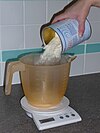Wikipedia:Today's featured article/January 17, 2010
The ketogenic diet is a high-fat, adequate-protein, low-carbohydrate diet primarily used to treat difficult-to-control epilepsy in children. This medical nutrition therapy mimics aspects of starvation by forcing the body to burn fats rather than carbohydrates. Normally, the carbohydrates contained in food are converted into glucose, which is then transported around the body and is particularly important in fuelling brain function. However, if there is very little carbohydrate in the diet, the liver converts fat into fatty acids and ketone bodies. The ketone bodies pass into the brain and replace glucose as an energy source. The diet provides just enough protein for body growth and repair, and sufficient calories to maintain the correct weight for age and height. Developed in the 1920s, the classic ketogenic diet contains a 4:1 ratio by weight of fat to combined protein and carbohydrate. This is achieved by excluding high-carbohydrate foods such as starchy fruits and vegetables, bread, pasta, grains and sugar, while increasing the consumption of foods high in fat such as cream and butter. The diet, which is closely supervised by a neurologist and a dietitian, is effective in half of the patients who try it, and very effective in a third. The mechanism by which the ketogenic diet reduces the frequency of epileptic seizures is unknown. (more...)
Recently featured: Solomon P. Sharp – Emery Molyneux – The Dark Side of the Moon

